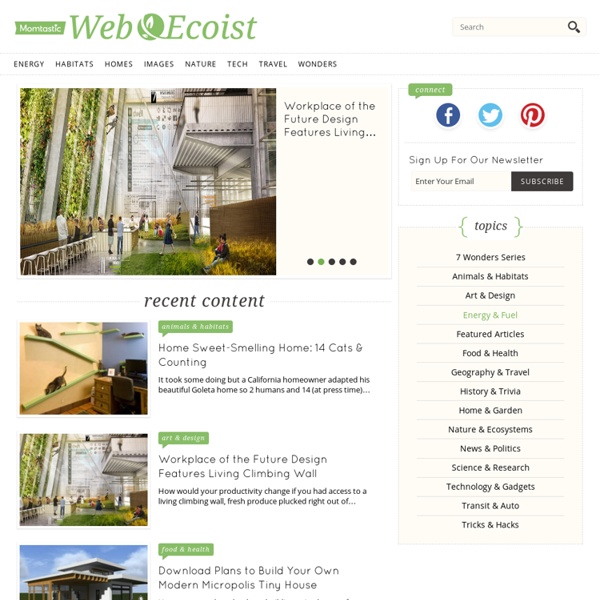



crash course:green search engines Ecosia, Earthle, Znout, Greenspec and Ecocho. No these words aren’t Esperanto gone mad, they are only five of the dozens of environmentally friendly internet search engines I’ve come across recently. We may not think about it when we type a search term into the web (and if you work for a research consultancy you’ll be doing this countless times a day) but search engines are run by massive power-hungry server networks. Take Google, for example, which has a 70% market share and gets hundreds of millions of queries a day. There are three main types of eco-friendly search engines out there. The second type of green search engine is those which are purposely built to seek out environmental information for the user. The third, and final, type of environmentally friendly search resources are those that give a proportion of their profits from their sponsorship advertisement and retail revenue to charitable green causes. From this little snap shot research many questions emerge, for instance:
CULD Complex Urban Landscape Design Design Ideas and Tech Concepts - Toxel.com Welcome to WWF's global network The Zombie Nation Webcomic - Zombies Defined What defines a zombie? What can cause a zombie? Where does the idea of a zombie even come from? These are the questions that keep me up at night. So far I have been unable to find any satisfactory answers (Nerds arguing back and forth doesn’t count). First we need a definition, but we need a more inclusive definition than “If it’s fast, it’s not a zombie.” So here is “Zombie Carter’s Unified theory of Zombiism.” My Zombie Definition Main Entry: zom·bieVariant(s): also zom·bi \ˈzäm-bē\Function: nounEtymology: Louisiana Creole or Haitian Creole zonbi, of Bantu origin; akin to Kimbundu nzúmbe ghostDate: circa 1871 1. Yeah! Look, I realize that you all love George Romero, and “Night of the Living Dead” is a super nifty movie. I think we can all agree that he did the world a great service by showing us the “abject horror that awaits us all” and how we’re all going to die painfully. Zombie Subspecies Classification Project Biological Zombies Metaphysical Zombies Chemical Zombies Energy Zombies
EcoSearch Bionic Tower The Bionic Tower is a proposed vertical city, an extremely large building designed for human habitation designed by Spanish architects Eloy Celaya, Mª Rosa Cervera, and Javier Gómez. It would have a main tower 1,228 metres (4,029 ft) high, with 300 stories housing approximately 100,000 people. The bionic tower would be exactly 400 meters taller than the current tallest building, Burj Khalifa. The Bionic Tower is composed of two complexes put together. In 1997 work on the prototype Bionic Vertical Space began. While in office, then-Shanghai mayor Xu Kuangdi expressed an interest in the concept for his city. Specifications[edit] See also[edit] References[edit]
GPII - Green Products Innovation Initiative Newsletter August 22 is Earth Overshoot Day - Footprint Network News Dear Global Footprint Network friends, Today, August 22, is Earth Overshoot Day, marking the date when humanity has exhausted nature’s budget for the year. We are now operating in overdraft. Earth Overshoot Day (from a concept devised by the UK think tank new economics foundation) helps conceptualize the gap between what nature can regenerate, and how much is required to support human activities. In the past year, severe economic and environmental crises have reverberated across the globe—ranging from the European debt predicament and extreme weather events to grain shortages, groundwater depletion and overfishing—affecting many among a world population that has surpassed the 7 billion mark. “Nations around the world, and particularly in the south of Europe, have started to painfully experience what it means to spend more money than what they earn,” said Dr. Today, humanity is using the equivalent of just over 1.5 Earth’s worth of ecological resources and services.
EcoEarth bionic tower January 1997, a full team of architects, engineers, biologists and designers join their capacities and investigations and start to develop the Prototype "Bionic Vertical Space" ideologically and physically. The result is presented at the "III International Conference IFHS", as a lecture titled "Conquest of Vertical Space in the 21st Century - International Conference on Multipurpose High-Rise Towers and Tall Buildings" organized by "The Concrete Society" in London, October, 1997. The Original Lecture is signed by the Architects Eloy Celaya, Javier Gómez and the Engineer Javier Manrique. At that moment "Bionic Tower Vertical City" starts its pace and development until the beginning of the year 2001, being this project directed by Architects Eloy Celaya, Javier Gómez and Mª Rosa Cervera. Actually "Bionic Tower" Project is known all around the world and it is trying to establish its final situation and the necessary infrastructure to carry out the project. Future, uncertain, but hopeful.
design durable - Filed under 'écodesign' Une poignée de produits a fait preuve de créativité et d'innovation dans la ré-imagination de la façon dont nous utilisons nos choses. Les résultats, bien que variés, progressent vers des biens qui ont un meilleur rendement énergétique, qui sont plus chics et plus efficaces. L'application la plus directe consiste en des produits dont le but est de changer le comportement de l'utilisateur. Le Power Aware Cord et plusieurs nouveaux moniteurs d'énergie domestiques incluant l'EnergyHub, The Energy Detective et le très médiatisé Wattson, son destinés à influencer les comportements en fournissant un retour d'information en temps réel qui montre aux utilisateurs la quantité d'énergie utilisée par leurs appareils électroménagers. Mais je trouve ceux-ci encore plus intéressants : les produits qui essayent d'empêcher les utilisateurs de se comporter de manière non viable.